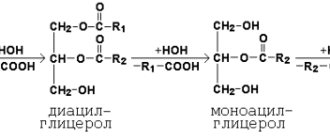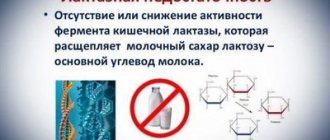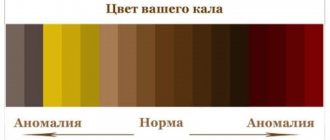Acute appendicitis
Appendicitis is an acute inflammation of the inner lining of the appendix. It is the most common cause of acute surgical interventions and most often occurs between 10 and 30 years of age.
The pain usually starts in the center of the abdomen, then moves down to the lower right side. As a rule, it intensifies within 12-18 hours and becomes very pronounced.
Treatment for appendicitis involves immediate surgical removal of the appendix. Without surgery, it leads to serious complications.
Synonyms Russian
Inflammation of the appendix.
English synonyms
Appendicitis.
Symptoms
- Aching pain in the abdomen that begins in the navel area and then usually moves to the lower right side of the abdomen.
- Short-term nausea, vomiting.
- Loss of appetite, constipation.
- Abdominal pain that gets worse over several hours.
- Acute pain in the lower right part of the abdomen, which occurs when pressure suddenly decreases during palpation.
- Abdominal pain, aggravated by coughing, walking, or sudden movements.
- Pain in the lower right abdomen when palpated.
- Increase in body temperature to 37.7-38.3 °C.
- In children under 3 years of age, behavior changes and refusal to eat, as well as diarrhea and vomiting.
- In elderly patients, symptoms may not be expressed.
The difficulty lies in the fact that typical symptoms are characteristic of only 50% of patients. Sometimes abdominal pain may be absent, not localized to the right side, etc. Atypical symptoms are usually observed in older people and pregnant women.
General information about the disease
Appendicitis is an acute inflammation of the inner lining of the appendix - the vermiform appendix of the cecum (the cecum is the initial section of the large intestine in the lower right part of the abdomen; the appendix is a small appendix of the cecum, the function of which in the body has not yet been precisely established). It is the most common cause of acute surgical interventions and most often occurs between 10 and 30 years of age.
Inflammation of the appendix is caused by its blockage, which may be associated with increased pressure in the intestinal lumen. This may happen due to:
- lymphoid hyperplasia - an increase in lymphoid tissue located fragmentarily along the intestinal wall;
- fecal stones (fragments of hardened feces);
- parasites;
- foreign bodies, tumors.
The blockage leads to expansion of the process and infection. As a result, the outflow of venous blood from the appendix is disrupted, which causes oxygen starvation of its tissues.
Also, in some cases, appendicitis is a consequence of inflammatory or infectious bowel diseases.
The following types of appendicitis are distinguished.
- Catarrhal (simple). It occurs most easily and is characterized by minimal inflammation of the appendix. In this case, suppuration does not occur.
- Phlegmonous. The appendix ulcerates, becomes inflamed and suppurates.
- Gangrenous. It is a consequence of thrombosis of the vessels feeding the appendix, resulting in tissue necrosis, which leads to peritonitis - inflammation of the peritoneum (the membrane covering all organs of the abdominal cavity). This type of appendicitis is extremely dangerous.
- Perforated. When it occurs, suppuration of the appendix occurs, followed by melting of the tissues, a hole is formed in the appendix and its contents enter the abdominal cavity. This causes inflammation of the peritoneum, which is accompanied by systemic inflammation of the entire body. Accompanied by severe pain.
The appendix may be located in an atypical location: behind the cecum, in the pelvis, close to the liver. In this case, the symptoms will differ significantly from the classic ones and resemble the signs of other diseases. Making a diagnosis with an atypical location of the appendix can be difficult. In addition, the position of the appendix changes during pregnancy, which can also complicate diagnosis.
Appendicitis can lead to the following complications.
- Appendicular infiltrate is a formation consisting of the cecum, appendix, loops of the large intestine and omentum. It is formed at the location of the appendix on the 3-5th day from the onset of acute appendicitis and usually resolves on its own within a month. In some cases, it may suppurate with the formation of a periappendiceal abscess.
- Peritonitis is an inflammation of the peritoneum, the membrane that covers all organs of the abdominal cavity from the outside.
- Periappendicular abscess is a purulent inflammation of tissues, their melting and the formation of a purulent cavity. The appearance of an abscess requires its surgical removal.
Who is at risk?
- People aged 10-30 years.
- Suffering from inflammatory bowel disease.
- Suffering from parasitic intestinal diseases.
- Pregnant women.
Diagnostics
If classic symptoms are present, the diagnosis of appendicitis is usually not in doubt. In case of atypical or erased symptoms, additional research is required to diagnose it.
Laboratory research
- Complete blood count (without leukocyte formula and ESR). In 80-85% of patients with appendicitis, the level of white blood cells increases. At the same time, their normal number does not exclude the presence of appendicitis. Since during pregnancy there is a physiological increase in the level of leukocytes, a general blood test in this case does not help in diagnosing the disease.
- Leukocyte formula. Determines the ratio of different types of leukocytes as a percentage. With appendicitis, a significant predominance of neutrophilic leukocytes can be observed.
- C-reactive protein. It is a protein produced in the liver that quickly responds to active inflammation. A normal CRP level practically excludes the diagnosis of appendicitis, but an increase in its level is not specific for appendicitis. The test is especially reliable in combination with determining the level of leukocytes.
- General urine analysis. This is done to rule out urinary tract infections and kidney stones.
- Determination of hCG level. The study is prescribed to women to exclude ectopic pregnancy.
To exclude diseases of the liver and pancreas, the following tests are performed:
- aspartate aminotransf
Clinical picture of biochemical studies in inflammation of internal organs
The chemical composition of human blood is a constant value. They donate blood for analysis in order to find out the quantitative relationships of its components. If the levels of white and red blood cells are increased, the composition of the plasma has changed, then you need to start treatment without delay.
A mandatory laboratory test for the presence of leukocytes in the blood is prescribed if inflammation of the appendix is suspected. During acute inflammatory processes, the composition of human blood changes due to the ingress of bacterial metabolic products into it. Leukocytes with appendicitis increase in size and number.
Leukocytes in the body
They are the main tool of immunity, but at the first stage of inflammation this increase is imperceptible. The state of red blood cells also changes. Their number is not subject to strong fluctuations, but inflammation shortens the lifespan of the red blood cell.
Urine also changes its composition, which correlates with the type of disease. The amount of dead leukocytes and red blood cells in it increases, the alkaline reaction changes, and the most severe cases are accompanied by the appearance of protein. To determine appendicitis using a blood test, it must be taken early in the morning on an empty stomach.
Differences between blood tests in adults and children
Blood tests for children are highly dependent on the individual condition of each child. The metabolic rate of a child's body is much higher than that of an adult. The leukocyte is actively involved in metabolism. Their amount in the blood of children significantly exceeds the proportions for older people.
Analysis indicators
The correct indicators for a mature person in relative values of leukocytes are from 4 to 8 units. In children they can reach 17. During pregnancy – 12-18. If leukocytes exceed 20, then there is a suspicion of peritonitis - a severe form of appendicitis that requires urgent surgical intervention. The decision about the severity of the disease should be made by specialized specialists - a pediatrician and a gastroenterologist. Since in acute peritonitis the patient’s death is likely due to blood poisoning, it is important not to miss the moment.
Signs of appendicitis
Other signs of appendicitis:
- Physiological signs. An increase in temperature, painful lumps in the lower abdomen, vomiting, and loose stools are the first external signs. If the disease has progressed, bloody discharge may appear in the stool and urine. In particularly difficult cases, a fistula develops with access to the skin.
- Changes in the composition of urine. The vital activity of pathogenic microorganisms is reflected in all body secretions. The kidneys separate metabolic products, signaling the onset of the disease by the changed chemical composition of the filtrate. If proteins appear in the general urine analysis, the bacterial background is increased, and its color takes on an unhealthy, cloudy appearance, this is a sure sign of internal inflammation.
- ESR. An ESR (erythrocyte sedimentation rate) analysis is designed to show what stage the disease is at. The activity of red blood cells varies depending on the state of the body. The inflammatory process provokes red blood cells to increase the consumption of their resources. ESR shows how long these cells live. Expressed in the height of the plasma layer and measured in millimeters per unit of time. In a healthy man it is 1-10 millimeters per hour, in a woman 3-15, in a child 12-17, in a newborn 0-2.
- However, only the results of a comprehensive examination, taking into account the total number of leukocytes and erythrocytes, will help to draw a conclusion about the nature of the disease.
How does appendicitis hurt?
Maximum pain during inflammation of the appendix occurs in the area where it is located, that is, slightly to the right of the umbilical cord. The pain of the appendix, raised closer to the liver, is not difficult to confuse with the pain of the liver itself. If the appendix is lowered to the pelvis, then its pain is masked as an ovarian pathology; in men, as an inflammation of the bladder. When the appendix is located posteriorly, the pain is localized in the lower back and felt in the groin.
Pain appears unexpectedly, without any particular reason. The inflammatory process can begin with mild or tolerable pain, followed by an increase, or it can immediately manifest itself with acute stabbing pain, which will be acute and unbearable as long as living nerve endings are sensitive. Therefore, when the appendix is inflamed, you cannot calm down if the pain subsides. On the contrary, the patient must be urgently hospitalized.
Appendicitis is also characterized by other symptoms: general malaise, nausea, and even single vomiting appear. Lost appetite. The temperature rises to 37.2-37.7o C and may be accompanied by chills. A light coating appears on the tongue. The heart rate increases to 90-100 beats per minute.
Treatment
A worldwide recognized and effective method for accurate diagnosis and surgical treatment is diagnostic laparoscopy followed by appendectomy - removal of the inflamed appendix.
Appendectomy Removal of the vermiform appendix (appendix)
Access - laparoscopic, if there are no contraindications
Operation time - 1 hour
Time of stay in hospital - from 2 days
Cost of the operation: from 53,900 rubles. *(excluding the cost of anesthesia and hospital stay)
Find out the cost of the operation
Have questions?
Leave your phone number and we will call you back
Beginning of the acute phase of inflammation
The cecum performs the function of storing enzymes necessary for digestion and immune function. It is isolated from the intestines, and this causes suppuration when the immune system is weakened.
Diagnosis based on a high white blood cell count clearly indicates inflammation. This condition is called leukocytosis. It is necessary to determine whether an acute inflammatory process has begun in cases of suspected appendicitis as quickly as possible! This disease is dangerous with complications. Prompt treatment with modern antibiotics and close clinical supervision can completely stop the disease at this stage. Strict adherence to the recommendations guarantees complete recovery, and failure to comply will lead the disease to the chronic stage.
Determining the beginning of the inflammation process
How to determine appendicitis at home without doctors: you don’t need to be a medical professional to make an assumption. The pathological process occurs with various clinical signs, the main of which is pain in the abdomen. Discomfort accompanies not only inflammation of the appendix, but also other diseases; because of this feature, patients are prohibited from taking painkillers.
Anesthetics provide relief, but cause diagnostic problems. Everyone should know the standard symptoms of appendicitis so that they can contact specialists in a timely manner. The list of standard clinical signs includes:
- constant pain syndrome - in the abdominal area;
- Kocher's symptom - pain from the epigastric region gradually moves to the right iliac region;
- Sitkovsky's symptoms - when lying down, on the left side, the unpleasant sensations intensify due to the pressure of the intestines on the inflamed area.
Additionally, patients experience a lack of appetite and a rise in temperature to subfebrile levels of 38 degrees. Attacks of nausea and vomiting, diarrhea, and frequent urination may occur.
How to treat appendicitis?
The pathology requires immediate treatment, since the appendage may burst and its contents will spill into the abdominal cavity and peritonitis will begin. Therefore, the only solution is to remove the appendix surgically.
Appendectomy is a surgical operation to remove the appendix. It can be carried out in two ways:
- classic – abdominal surgery
- laparoscopic, when there are no large incisions
Abdominal surgery is performed if the appendix ruptures and if its contents spill into the abdominal cavity, as well as if the rupture causes an abscess.
Laparoscopy is considered the most modern method of removing the appendix for various reasons: less invasiveness, quick recovery, and fewer complications.
The operation is carried out as follows:
- the surgeon makes small incisions through which access to the appendix appears
- a camera with illumination is introduced
- other instruments are used to remove the process
- areas are treated to disinfect infectious material
- the operated area is examined and sutures are placed









